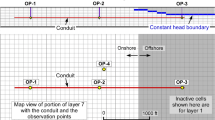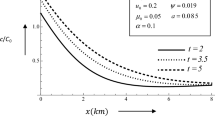Abstract
Case 5, Level 1 of the international HYDROCOIN groundwater flow modeling project is an example of idealized flow over a salt dome. The groundwater flow is strongly coupled to solute transport since density variations in this example are large (20%).
Several independent teams simulated this problem using different models. Results obtained by different codes can be contradictory. We develop a new numerical model based on the mixed hybrid finite elements approximation for flow, which provides a good approximation of the velocity, and the discontinuous finite elements approximation to solve the advection equation, which gives a good approximation of concentration even when the dispersion tensor is very small. We use the new numerical model to simulate the salt dome flow problem.
In this paper we study the effect of molecular diffusion and we compare linear and non‐linear dispersion equations. We show the importance of the discretization of the boundary condition on the extent of recirculation and the final salt distribution. We study also the salt dome flow problem with a more realistic dispersion (very small dispersion tensor). Our results are different to prior works with regard to the magnitude of recirculation and the final concentration distribution. In all cases, we obtain recirculation in the lower part of the domain, even for only dispersive fluxes at the boundary. When the dispersion tensor becomes very small, the magnitude of recirculation is small. Swept forward displacement could be reproduced by using finite difference method to compute the dispersive fluxes instead of mixed hybrid finite elements.
Similar content being viewed by others
References
Ackerer, Ph., Younès, A. and Mosè, R.: Modeling variable density flow and solute transport in porous medium: 1. Numerical model and verification, Transport in Porous Media 35, 345–373 (this issue).
Andersson, K., Grundfelt, B., Hodgkinson, D. P., Lindbom, B. and Jackson, C. P.: 1986, HYDROCOIN level 1 final report: verification of groundwater flow models, Swed. Nucl. Power Inspectorate (SKI).
Atkinson, R., Herbert, A. W., Jackson, C. P. and Robinson, P. C.: 1985, NAMMU User guide, Harwell Rep. AERE-R.11364, Her Majesty's Stationary Off., London.
Bear, J.: 1979, Hydraulics of Groundwater, McGraw-Hill, New York.
Chavent, G. and Roberts, J. E.: 1991, A unified physical presentation of mixed, mixed hybrid finite elements and standard finite difference approximations for the determination of velocities in water flow problems, Adv. Water Resour. 14(6), 329–348.
Diersch, H. J. and Kolditz, O.: 1998, Coupled groundwater flow and transport: 2. Thermoline and 3D convection systems, Adv. Water Resour. 21, 401–425.
Gupta, S. K., Kincaid, C. T., Meyer, P. R., Newbill, C. A. and Cole, C. R.: 1983, CFEST, multidimensional finite element code for the analysis of coupled fluid, energy and solute transport, Rep. PNL-4260, Pac. Northwest Lab., Richland, Washington.
Herbert, A.W., Jackson, C. P. and Lever, D. A.: 1988, Coupled groundwater flowand solute transport with fluid density strongly dependent on concentration, Water Resour. Res. 24(10), 1781–1795.
Johns, R. and Rivera, A.: 1996, Comment on ‘Dispersive transport dynamics in a strongly coupled groundwater-brine flow system’ by C. Oldenburg and K. Pruess, Water Resour. Res. 32(11), 3405–3410.
Konikow, L. F., Campbell, P. J. and Sanford, W. E.: 1996, Modelling brine transport in a porous medium: a re-evaluation of the HYDROCOIN Level 1, Case 5 problem, In: K. Kovar and P. Van Der Heijde (eds), Calibration and Reliability in Groundwater Modeling, IAHS Publ. 237, pp. 363–372.
Konikow, L. F., Sanford, W. E. and Campbell, P. J.: 1997, Constant concentration boundary conditions: lessons from theHYDROCOIN variable-density groundwater benchmark problem,Water Resour. Res. 33(10), 2253–2261.
Mosè, R., Siegel, P., Ackerer, P. and Chavent, G.: 1994, Application of the mixed hybrid finite element approximation in a groundwater flow model: luxury or necessity ? Water Resour. Res. 30(11), 3001–3012.
Oldenburg, C. M. and Pruess, K.: 1995, Dispersive transport dynamics in a strongly coupled groundwater-brine system, Water Resour. Res. 31(2), 289–302.
Oldenburg, C. M., Pruess, K. and Travis, B. J.: 1996, Reply on ‘Comment on Dispersive transport dynamics in a strongly coupled groundwater-brine system’ by Johns and Rivera (1996), Water Resour. Res. 32(11), 3411–3412.
Organization for Economic Cooperation and Development (OECD): 1988, The International Hydrocoin Project, Level 1, Code verification, Rep. 71617, Paris.
OECD, The International Hydrocoin Project, Level 3: 1992, Uncertainty and sensitivity analysis, Rep. 76319, Paris.
Pruess, K.: 1987, TOUGH user's guide, Nuclear Regulatory Commission, Report NUREG/CR-4645, June 1987 (also Lawrence Berkeley Laboratory Report, LBL-20700, Berkeley, California).
Pruess, K.: 1991, TOUGH2 – A general purpose numerical simulator for multiphase fluid and heat flow, Lawrence Berkeley Laboratory Report, LBL-29400, Berkeley, California.
Raviart, P. A. and Thomas, J. M.: 1977,Amixed finite method for the second order elliptic problems, In: I. Galligani and E. Magenes (eds), Mathematical Aspects of the Finite Element MethodsLecture Notes in Math. 606, Springer-Verlag, Berlin, pp. 292–315.
Reeves, M., Ward, D. S., Johns, N. D. and Cranwell, R. M.: 1986, Theory and implementation of SWIFT II, the Sandia waste-isolation flow and transport model for fractured media, Rep. SAND83-1159, Sandia Natl. Lab., Albuquerque, N.M.
Sauter, F.: 1987, User' manual METROPOL, mathematical description, Rep. 728514002, Rijksinst, voor Volksgezondh. en Milieuhyg., Bilthoven, Netherlands.
Siegel, P., Mosè, R., Ackerer, Ph. and Jaffrè, J.: 1997, Solution of the advection dispersion equation using a combination of discontinuous and mixed finite elements, Int. J. Numer. Methods Fluids 24, 595–613.
Voss, C. I.: 1984, A finite element simulation model for saturated–unsaturated fluid-densitydependent ground-water flow with energy transport or chemically-reactive single species solute transport, U.S. Geol. Surv. Water Resour. Inv., 84-4379, p. 409.
Author information
Authors and Affiliations
Rights and permissions
About this article
Cite this article
Younes, A., Ackerer, P. & Mose, R. Modeling Variable Density Flow and Solute Transport in Porous Medium: 2. Re‐Evaluation of the Salt Dome Flow Problem. Transport in Porous Media 35, 375–394 (1999). https://doi.org/10.1023/A:1006504326005
Issue Date:
DOI: https://doi.org/10.1023/A:1006504326005




